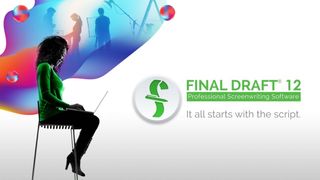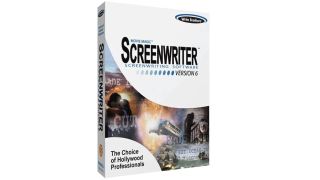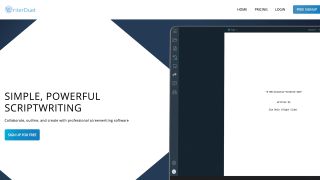Using the best screenwriting software can massively improve your writing process. These programs make it easy to format your script, offering features like beat boards and story maps, so that you can track progress and check that you’re hitting all the right narrative marks. They also make it easy to collaborate with other writers on a project, as they offer you the chance to store and edit your work online.
Some script writing software is free, but in our opinion the best screenwriting software – the sort that is used by the professionals – tends to be in the paid-for category. Although these options are sometimes pricey, the tools and features they offer are invaluable to busy screenwriters who need to save time on formatting.
Out of all the packages we tested, we think that Final Draft 12 is the best option for most people. It has the most comprehensive range of tools available, with features that let you track changes and an interface that feels intuitive and easy to use. The latest version also has brilliant importing capabilities, which can be a massive time saver if you have a PDF that you need to reformat and edit.
If you’re ready to turn your screenplay into something more solid – or you already have a film that needs a little tweaking – then do check out our guides to the best video editing software and best audio editing software, too.
1. Final Draft 12: Best screenwriting software overall
Why you can trust Top Ten Reviews

According to the Final Draft website, this software is used in around 95% of film and television production – and it’s easy to see why. With a clear interface that lets you color-code things like story beats, acts, characters and locations, the software makes it simple to see an overview of your full project.
Collaboration is also easy; just one click of a button will allow you to invite partners to join in with the editing and writing process online, while a chat tool allows you to discuss story decisions. The program lets you track changes and see who made them, too, so you can quickly compare past versions with new scenes. And the new ‘focus’ feature makes it simple to ignore all of these new bells and whistles if you want to and simply get into the flow of writing.
Its usefulness doesn’t end when you’ve finished writing, either, as Final Draft 12 also has production-tracking tools, which show you how the script is managed once its moved into the filming or performance stage.
The only real downside we can find to the package is its cost. It’s one of the most expensive options, at $249.99, but it is – in our view – the clear industry leader. If you’re just starting out with screenwriting, then it might be better to go for a cheaper option (although this package does currently offer a 60 day free trial period.) That said, having your script professionally formatted by a program like Final Draft 12 will give you an edge when submitting it for consideration to a production company.
- Read our Final Draft 11 review
2. Movie Magic Screenwriter: Best professional budget option

Movie Magic Screenwriter is a less expensive option than Final Draft, but one that still offers many of the features you need – and it's widely used by professionals, too. Note tools allow you to jot down distracting ideas that pop in your head, and an outline view helps you keep track of characters and scenes. For example, you can use a filter to isolate a character to remind yourself what they were doing five scenes ago. When you’ve been writing a long time, details get cloudy. Movie Magic Screenwriter can also color-code scenes, characters and actions. You can filter by a color and look at characters from a certain family or group.
Movie Magic screenwriting software comes with plenty of templates with a variety of formats for screenplays, television scripts and even novels, to ensure that your spec script for a sitcom will be formatted correctly. It also has collaborative features to help you work on a script with another writer, and it has a text to speech option that lets you get a feel for how your lines sound when they're read aloud.
On the downside, it doesn't have a fully specced beat board, and it's quite tricky to learn all the ins and outs of the software. While it's used by many screenwriters, it doesn't have the same widespread adoption as Final Draft, so keep this in mind if you anticipate working with plenty of other people on your projects.
- Read our Movie Magic Screenwriter review
3. WriterDuet: Best for collaborations

If you're working on a screenplay with several other writers, something like WriterDuet is a great option. It's tailored towards several people working on the same project, and places emphasis on accessibility and collaboration with all its features. Because it's browser-based, meaning you don't have to physically download software to your computer, you can access your script from any laptop, PC, or mobile device. There's even a mobile app that streamlines the experience if you regularly use your phone to access scripts.
You pay for a subscription to WriterDuet, so you don't have to shell out for a single sum. There are various pricing options for whatever level of access you need, and even a free version, which is actually very useable (if a little limited). We did find the pricing tiers unnecessarily varied, as few will choose anything other than the Pro version.
All documents are compatible with other screenwriting software, like Final Draft, and you can import scripts of almost any type, work on them, before adding them back into whatever format they came from. It's a very versatile program, but one best used alongside something like Final Draft or Movie Maker to get maximum benefit.
- Read our WriterDuet review
4. Celtx: Best for production features

Celtx started out as a screenwriting tool, but has evolved more into a production management tool over the past few iterations. That's great if you're looking for something to look after script management, but there are better options out there for screenwriting and generation. What you do get is impressive, though, and you can also use Celtx across a number of different media, such as video games and other types of non-TV and movie video production, which is a neat bonus.
It's a subscription service, so you can work online and store all your scripts in the cloud. There are so many tools here for the whole production team it might appear intimidating, but Celtx is easy to use no matter what aspect you're working on. It's built so that multiple collaborators can work on a script at the same time, and you can tag and highlight elements in each section to make it easier to pinpoint aspects of the script. We also like the ability to create schedule calendars, and to coordinate a whole project as a team.
But that's just the thing: Celtx is weaker on the actual creation of scripts. We found the duplication tools tougher to use than the likes of WriterDuet and Final Draft, and it isn't as easy to import and export scripts as other programs. It's relatively inexpensive but if you're a screenwriter looking to generate scripts, we'd recommend something like Final Draft instead.
5. Scrivener: Best for book to script

Many screenwriters look to turn novels or other texts into scripts, and for this kind of writing, Scrivener is a good place to look. For $45 you get access to software that works like, and plays very nicely with, Microsoft Word (or similar word processing apps). The interfaces are very similar, and you get the same options for formatting and playing around with text. Importing text from the likes of Word is easy too, so if you're given drafts of published works, it's simple to pull them into Scrivener.
What's more, you can flip between whatever section you're working on and the overall work with ease, once you've gotten to grips with how it all works, so you can break down larger pieces of work into smaller chunks very effectively. There are organization and editing options, but they're not as fully fleshed out as those you'll find in Final Draft of Celtx. What we do like is the ability to have research notes side-by-side with your script, so you can cross-reference for accuracy at all times. This is invaluable if you're working on non-fiction scripts.
At $45, it's relatively cheap too (although you may have to pay for some upgrades), so it's perfect if you're at the start of a project and looking to generate a first draft script. Especially if you're working from source material to begin with.
What screenwriting software do professionals use?
In addition to researching and using each screenwriting program we reviewed, we also reached out to professionals who use screenwriting software everyday. Richard Dutcher is an independent film director who has produced eight feature films and written dozens of screenplays. We asked him which screenwriting software he uses and why.
“I use both Final Draft and Movie Magic Screenwriter, depends on which job I’m doing and if they have a preference. If it’s my own choice, I use Movie Magic Screenwriter,” Dutcher said. He explained that he started screenwriting in the late '90s and learned on the program Script Thing, which was later acquired by Movie Magic. “I just stuck to it because it was what I was used to,” Dutcher said.
We asked him about Celtx, Fade-in and Slugline as alternatives to the industry standard applications like Final Draft and Movie Magic. “I found I had to do too much tailoring in them. I couldn’t do what I wanted to do easily, and I don’t like to think about the formatting. I just like to sit down and write,” Dutcher said. “I found it to be too much distraction and time consuming to make the format to be what I consider professional formats. Otherwise, somebody has to convert it, and it never converts perfectly.”
Dutcher said, “To me, if you are a professional screenwriter or want to be a professional screenwriter, you definitely have to be using professional software. Even if you’re just at home pounding something out for a screenplay competition or you hope maybe to get in a producer, it shouts ‘amateur screenwriter’ if you're not using a professional software program.”
Do I need screenwriting software?
There are so many benefits to writing with the best screenwriting software that it's hard to say no on this one. While you can technically produce scripts on any word processing program, screenwriting software saves you lots of time by handling the formatting for you. It can easily interpret when you're typing scene headings, names and stage directions, so you don't have to manually move around bits of text.
The studios behind the packages also have active, engaged online communities attached to them. This is great if you get stuck with a particular technical issue, as you can fire a question out into the forum and someone will usually be able to help. Some of the companies run big screenwriting competitions, too, where you can get access to their software for a limited amount of time – and potentially win money by submitting your script.
The importance of outlining your script
Outlines are vital for all writers, whether you’re just starting out or a seasoned professional. Trying to write a full-length screenplay without an outline is like trying to navigate a ship without a map and compass. If you know where your story is going, your ability to reach that destination is much smoother.
The best screenwriting software understands the value of outlines. The notecards should be intuitive and easy to find. Before you begin writing the first line of dialogue, you should outline every scene from start to finish with a logline, the motivation of the characters in the scene and why the scene is useful for moving the plot. Color coding and scene breakdowns are valuable for production as well. A good program will isolate specific locations so that the cinematographer and director can shoot multiple scenes that aren’t necessarily in chronological order.

